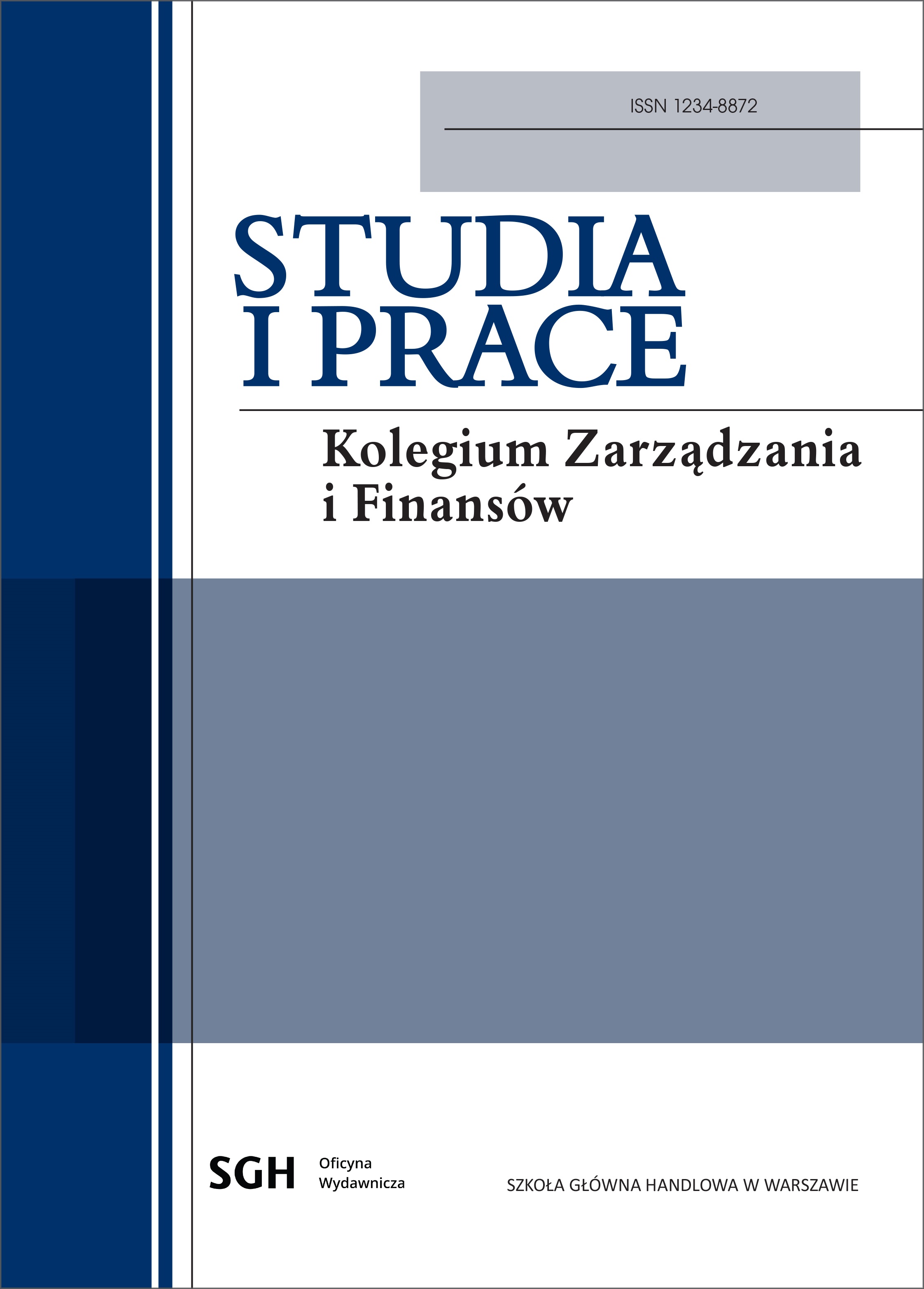Hybrydowa struktura organizacyjna z perspektywy paradoksu eksploracji i eksploatacji
DOI:
https://doi.org/10.33119/SIP.2022.183.8Słowa kluczowe:
struktura hybrydowa, strukturalna dyferencjacja, koordynacja, ambidexterity, wiek firmy, wielkość, faza rozwojuAbstrakt
Paradoksy są wszechobecne we współczesnym zarządzaniu organizacjami, a jednym z nich jest paradoks eksploracji i eksploatacji. Chcąc realizować z powodzeniem obie te aktywności, przedsiębiorstwa potrzebują odpowiednich struktur łączących cechy z różnych modelowych rozwiązań. Potrzebują zatem struktur hybrydowych. Celem artykułu jest identyfikacja i ocena struktur organizacyjnych przedsiębiorstw funkcjonujących w Polsce z perspektywy realizacji strategii oburęcznej i przy uwzględnieniu wieku, wielkości oraz fazy rozwoju przedsiębiorstwa.
Na podstawie badań przeprowadzonych na próbie 363 firm stwierdzono, że hybrydowe rozwiązania organizacyjne oparte na silnej strukturalnej dyferencjacji oraz towarzyszących jej formalnych mechanizmach koordynacji charakteryzują firmy większe i starsze, które realizują działania eksploracyjne i eksploatacyjne w sposób symultaniczny.
Downloads
Bibliografia
2. Bratnicka-Myśliwiec K. [2017], Twórczość w przedsiębiorstwie. Perspektywa obustronności organizacyjnej, Wydawnictwo Uniwersytetu Ekonomicznego w Katowicach, Katowice
3. Burgelman R. A. [2002], Strategy as Vector and the Inertia of Coevolutionary Lock-in, „Administrative Science Quarterly”, 47 (2), https://doi.org/10.2307/3094808
4. Chang Y. Y., Hughes M. [2012], Drivers of Innovation Ambidexterity in Small- to Medium-Sized Firms, „European Management Journal”, 30 (1).
5. Czakon W. [2015], Rygor metodologiczny, w: Podstawy metodologii badań w naukach o zarządzaniu, red. W. Czakon, Oficyna a Wolters Kluwer business, Warszawa.
6. De Leeuw E. [2005], To Mix or Not to Mix Data Collection Modes in Surveys, „Journal of Official Statistics”, 21 (5).
7. De Paula R. A., Brasil V. C., Maranzato F. P., Salerno M. S., Marx R. [2016], Exploration: Open Questions in Organizational Analysis, What We Know and What We Do Not Know, IAMOT 2016–25th International Association for Management of Technology Conference, Proceedings: Technology – Future Thinking, January.
8. Flaszewska S. [2016], Projektowanie organizacyjne w zarządzaniu wiedzą, Wydawnictwo Naukowe PWN, Warszawa.
9. Flaszewska S., Szymańska K. [2013], Organizacja w rozwoju – od narodzin do dojrzałości organizacji, w: Nauka o organizacji. Ujęcie dynamiczne, red. A. Adamik, Oficyna Wolters Kluwer Business, Warszawa.
10. Flaszewska S., Zakrzewska-Bielawska A. [2017], Struktura organizacyjna jako wsparcie dla procesu dzielenia się wiedzą w przedsiębiorstwie, „Organizacja i Kierowanie”, 176 (2).
11. Griffin R. W. [2021], Podstawy zarządzania organizacjami, Wydawnictwo Naukowe PWN, Warszawa.
12. Gupta A. K., Smith K. G., Shalley C. E. [2006], The Interplay between Exploration and Exploitation, „Academy of Management Journal”, 49 (4), https://doi.org/10.5465/amj.2006.22083026
13. He Z. L., Wong P. K. [2004], Exploration vs. Exploitation: An Empirical Test of the Ambidexterity Hypothesis, „Organization Science”, 15 (4).
14. Jansen J. J. P., Tempelaar M., van den Bosch F. A. J., Volberda H. W. [2009], Structural Differentiation and Ambidexterity: The Mediating Role of Integration Mechanisms, „Organization Science”, 20 (4), https://doi.org/15
15. Jansen J. P., Van Den Bosch F. A. J., Volberda H. W. [2006], Exploratory Innovation, Exploitative Innovation, and Performance: Effects of Organizational Antecedents and Environmental Moderators, „Management Science”, 52 (11), https://doi.org/10.1287/mnsc.1060.0576
16. Junni P., Sarala R. M., Taras V., Tarba S. Y. [2013], Organizational Ambidexterity and Performance: A Meta-Analysis, „Academy of Management Perspectives”, 27 (4), https://doi.org/10.5465/amp.2012.0015
17. Kaleta A. [2013], Realizacja strategii, PWE, Warszawa.
18. Kortmann S. [2012], The Relationship between Organizational Structure and Organizational Ambidexterity, Springer, Gabler Verlag, Wiesbaden, https://doi.org/10.1007/978-3-8349-3630-1
19. Lubatkin M. H., Simsek Z., Ling Y., Veiga J. F. [2006], Ambidexterity and Performance in Small-to Medium-sized firms: The Pivotal Role of Top Management Team Behavioral Integration, „Journal of Management”, 32 (5), https://doi.org/10.1177/0149206306290712
20. March J. G. [1991], Exploration and Exploitation in Organizational Learning, „Organization Science”, 2 (1).
21. Mider D., Marcinkowska A. [2013], Analiza danych ilościowych dla politologów, ACAD, Józefów.
22. Nalepka A., Kozina A. [2007], Podstawy badania struktury organizacyjnej, Wydawnictwo Akademii Ekonomicznej w Krakowie, Kraków.
23. O’Cass A., Heirati N., Ngo L. V. [2014], Achieving new Product Success via the Synchronization of Exploration and Exploitation across Multiple Levels and Functional Areas, „Industrial Marketing Management”, 43 (5), https://doi.org/10.1016/j.indmarman.2014.04.015
24. O’Reilly C. A., Tushman M. L. [2013], Organizational Ambidexterity: Past, Present, and Future, „Academy of Management Perspectives”, 27 (4), https://doi.org/10.5465/amp.2013.0025
25. Raisch S. [2009], Organizational Ambidexterity: Balancing Exploitation and Exploration for Sustained Performance, „Organization Science”, 17 (2), https://doi.org/10.1287/orsc.
26. Signore M., Brancato G., Simeoni G. [2017], Multi-Mode Data Collection: What Can Still Be Expected?, https://www.researchgate.net/profile/Giorgia-Simeoni/publication/252896540_Multimode_Data_Collection_What_Can_Still_Be_Expected/links/54e-5a02c0cf29865c33752b3/Multimode-Data-Collection-What-Can-Still-Be-Expected.pdf
27. Simsek Z. [2009], Organizational Ambidexterity: Towards a Multilevel Understanding, „Journal of Management Studies”, 46 (4).
28. Stańczyk S. [2015], Triangulacja – łączenie metod badawczych i urzetelnienie badań, w: Podstawy metodologii badań w naukach o zarządzaniu, red. W. Czakon, Oficyna a Wolters Kluwer business, Warszawa.
29. Stelzl K., Röglinger M., Wyrtki K. [2020] Building an Ambidextrous Organization: A Maturity Model for Organizational Ambidexterity, „Business Research”, 13 (3), https://doi.org/10.1007/s40685-020–00117‑x
30. Tushman M. L., O’Reilly C. A. [1996], Ambidextrous Organizations: Managing Evolutionary and Revolutionary Change, „California Management Review”, 38 (4), https://doi.org/10.1080/09652540903536982
31. Úbeda-García M., Claver-Cortés E., Marco-Lajara B., Zaragoza-Sáez P. [2020], Toward a Dynamic Construction of Organizational Ambidexterity: Exploring the Synergies between Structural Differentiation, Organizational Context, and Interorganizational Relations, „Journal of Business Research”, 112 (October), https://doi.org/10.1016/j.jbusres.2019.10.051
32. Urbanowska-Sojkin E. [2016], Paradoksy w zarządzaniu strategicznymi przedsiębiorstwami, „Prace Naukowe Uniwersytetu Ekonomicznego we Wrocławiu”, 420.
33. Venkatraman N., Lee C., Iyer B. [2007], Strategic Ambidexterity and Sales Growth: A Longitudinal Test in the Software Sector, „Academy of Management Proceedings”, unpublishe.
34. Wit B. de, Meyer R. [2007], Synteza strategii, PWE, Warszawa.
35. Zakrzewska-Bielawska A. [2011], Relacje między strategią a strukturą organizacyjną w przedsiębiorstwach sektora wysokich technologii, Wydawnictwo Politechniki Łódzkiej, Łódź.
36. Zakrzewska-Bielawska A. [2014], Ewolucja struktur organizacyjnych – w drodze do elastyczności i innowacyjności, „Prace Naukowe Uniwersytetu Ekonomicznego we Wrocławiu”, 340, https://doi.org/10.15611/pn.2014.340.55
37. Zakrzewska-Bielawska A. [2015], Struktury organizacyjne sprzyjające odnowie organizacyjnej przedsiębiorstw ambidextrous approach, „Management Forum”, 3 (1), https://doi.org/10.15611/mf.2015.1.16
38. Zakrzewska-Bielawska A. [2021], Ambidextrous Strategy: Antecedents, Strategic Choices, and Performance, Routledge, New York, https://doi.org/10.4324/9781003127772-2
39. Zakrzewska-Bielawska A. (red.) [2020], Podstawy zarządzania. Teoria i ćwiczenia. Wydawnictwo Nieoczywiste, Warszawa.









